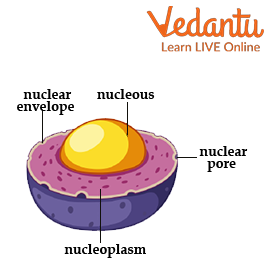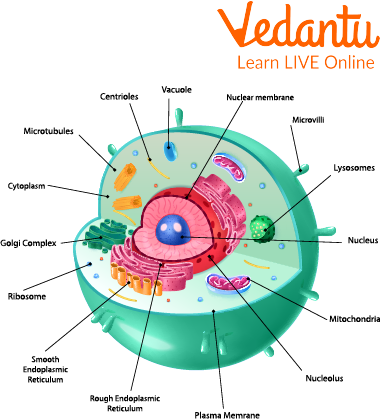




Overview of Nucleus
Biology is that portion of science that assists in our comprehension of the functioning, growth, and engagements of the living world's varied species, also consisting of humans. The class of living has been enhanced as a result of developments in the field of biology, including those which are in medicine, agriculture, biotechnology, and many other fields. Cells are a component of biology. When you look at a photograph of a cell, one of the parts that stand out the most is the nucleus. The nucleus, located at the centre of the cell, is home to all of the chromosomes, which are responsible for encoding the genetic material. Let's explore the subject further and learn more about function and structure of nucleus and the definition of nucleus.
What is Nucleus?
Due to its role in the storage, retrieval, and duplication of genetic information, the nucleus is regarded as one of the most significant components of eukaryotic cells. It is an organelle with two membranes that are linked to it that contains chromatin, which is a kind of genetic material. It is made up of an ever-changing variety of nonmembranous subcompartments with various functional capacities. The specific characteristics of a cell nucleus rely on how differentiated the cell is within the organism, particularly in terms of the type and location of subnuclear compartments and the positioning of the chromosomes.

Cell Nucleus
Function of Nucleus
The following are some crucial nuclear functions:
It accelerates the growth of cells and reproduction and also does the holding of information related to genes.
The genetic make of a cell consists in the nucleus, which is discussed deeply as a membrane-bound structure.
Apart from serving as a storage for DNA, it also serves as the location of various significant cellular functions.
In the nucleus, a person’s DNA can be duplicated firstly. DNA imitation is the procedure that makes an exact duplicate of the DNA.
Cell division starts with making 2 perfect copies of the body or host, with every new cell getting a distinct set of information.
Structure of Nucleus
The structure of the nucleus is quite complex. Let’s now see in detail about it and where the nucleus is located.
It is traditionally the cell organelle that is observed most commonly and easily.
Membranes surround and fully enclose the nucleus.
The structure surrounding it is the nuclear envelope.
The cytoplasm and nucleus's inside contents are divided by the membrane. The chromosomes of the cell are also included within it.
The chromosomes, which have the DNA, provide the genetic data mandatory for the synthesis of various cell components as well as for the continuation of life.

Structure of a Nucleus
Facts About the Nucleus
Some facts of nucleus are as follows:
The first cell organelle identified was the nucleus. Antonie von Leeuwenhoek identified the nucleus in fish blood skin cells in the late 1600s.
The Latin term nucleus, which means "kernel," is where the word nucleus first appeared.
Eukaryotic cells contain the nucleus, a double membrane-bound organelle.
In the nucleus, you can find DNA and RNA.
An organism's hereditary features are controlled by the nucleus.
In the nucleolus of the nucleus, proteins and ribonucleic acid (RNA) are also stored.
Transcription, the first step in the production of proteins, starts in the nucleus.
An enormous organelle is a nucleus. In reality, a basic compound microscope will allow you to see the nucleus.
A nuclear membrane encircles the nucleus. This membrane has two layers and resembles the cell membrane very much.
The extra components of the nucleus are encased and shielded by the nuclear membrane.
Ribosomes can also be found outside the nuclear membrane.
Nuclear pores are holes found on the nuclear membrane's outer surface. The messenger RNA exits the nucleus through a nuclear pore after transcription.
Summary
In this article, we have learned about the function and structure of nucleus and the definition of nucleus. The DNA or genetic material of an organism is found in the nucleus. It can direct all of a cell's operations and contains the knowledge necessary to produce the proteins that a cell needs. Since it indirectly manages the functions of the cell, it serves as the brain or control centre of the organism.
Because it regulates all of the cell's activities, its feeding cycle, and its reproduction, the nucleus is situated closer to the cell's centre. It can quickly access every area of the cell thanks to its central location. We hope you enjoyed reading this article, in case of any other doubts, feel free to ask in the comments.
FAQs on Facts About the Nucleus
1. Who gave the word "nucleus"?
When Robert Brown examined numerous plant cells under a microscope, he found an opaque region. The nucleus, as he put it.
2. Can a cell live without a nucleus?
The eukaryotic cell's nucleus serves as its administrative centre. It possesses DNA, which governs gene expression and drives the synthesis of proteins and enzymes in the cell, among other tasks. It directs cell division. Therefore, the majority of eukaryotic cells will perish without the nucleus.
3. Where did the nucleus originate?
This distinct division enables the conclusion that, in eukaryotes, the cytoplasm is of microbial sources whereas the nucleus is of archaeal origin.









